PhD Student Posts “Tools” That Psychotherapists May Provide In Therapy, And People Can’t Thank Her Enough (17 Pics)
Nawal Mustafa has always been interested in the human brain. In undergrad, she obtained a B.Sc in behavior, cognition, and neuroscience, and, like many millennials, she took a year off to decide what she wanted to do for graduate school. Ultimately, her heart was set on clinical neuropsychology because Mustafa finds it to be the perfect balance between the physical and psychological aspects of the human brain and how they influence behavior.
She's also doing something wonderful in her spare time. Since so many of us lack the resources to seek professional help for our mental health, the PhD student created an Instagram account to provide us with useful information we can use to better our well-being. Her insightful snippets are really comprehensive, and Mustafa's 131k followers can't thank her enough for the effort she puts into creating them.
More info: Instagram

#1
When anger and resentment accumulates in a relationship, it becomes very difficult to empathize with that person because of the pain you are holding inside. Naturally, it will be hard to support or care for that person when there are unhealed wounds from previous interactions. Overtime, this can result in a toxic relationship environment with no space left to be respected, heard, and loved.
One way to overcome resentment and rebuild the empathic bond is by communicating with the other person in a healthy way:
1. Set the intention together to talk about the issue with the goal of rebuilding empathy and to ease resentment.
2. Take turns to communicate with each other. This shows the other person that he/she/they are being heard and understood. After listening, express your experience and wishes in a non-threatening way. Try to use “I” statements instead of “You” statements (as shown in the post).
3. Press the restart button - set up a date/time with the other person when you officially commit to start over without holding resentment from the past. This is more effective when you make the date tangible by writing it down and laying out the terms of starting over.
Examples:
Why don’t you ever listen? —> “I feel unheard” or “I feel sad”
You are of no help at all! —> “I feel unsupported” or “I feel overworked”
You don’t care about me! —> “I feel unloved” or “I feel uncared for”
You are so insensitive —> “I feel disrespected”
“Why the heck would you do that!? —> “I feel that you overstepped a boundary”
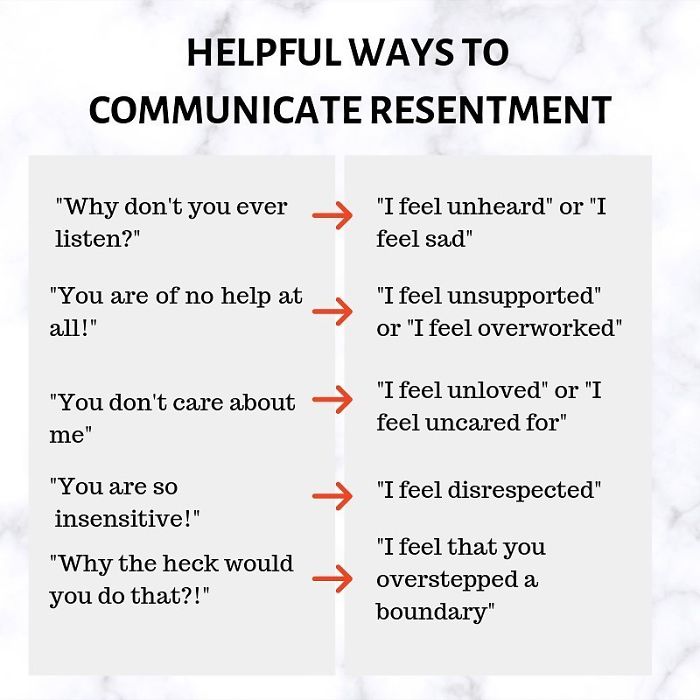
Image credits: thebraincoach
"So far, on my Instagram, I have been posting material related to mental wellness and psychotherapy because I am genuinely interested in raising awareness on these subjects," Mustafa told Bored Panda. "I started this page as a resource for those who may not have the means or courage to access professional help for their mental health. A lot of what I post are tools and information that psychotherapists may provide in therapy. The community we have created on Instagram has been such a gift."
Mustafa said she's not only able to share her knowledge with them, but she's also learning so much and connecting with like-minded individuals along the way.
#2
When we get upset or frustrated, it is easier to react (i.e. yell, scream, swear, stonewall) instead of responding, but it takes courage and self-awareness to be able to communicate our feelings. This can be healthy and productive if done the right way, but it can also lead to more frustration if done in a less effective way. In this post, I share with you some ways to identify the differences between helpful and unhelpful ways to communicate our anger. ⠀⠀⠀⠀⠀⠀⠀⠀⠀⠀⠀⠀⠀⠀⠀⠀⠀⠀⠀⠀⠀⠀⠀⠀⠀⠀⠀⠀⠀⠀⠀⠀⠀⠀⠀⠀⠀⠀⠀⠀⠀⠀⠀⠀⠀⠀⠀⠀⠀⠀⠀⠀⠀⠀
How do you communicate when frustrated or angry?
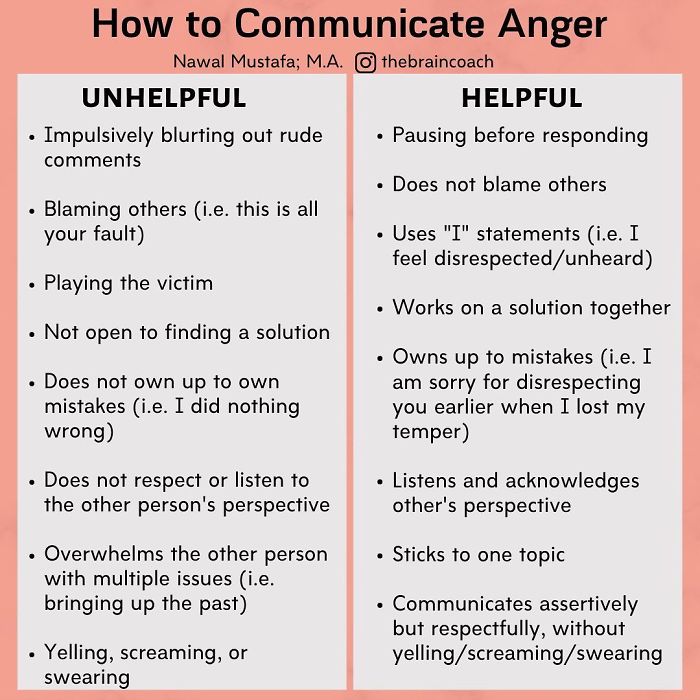
Image credits: thebraincoach
Judging from the attention her account has received, it's evident that people online need this. Also, Mustafa's approach to sharing mental healthcare online can lead people to try other digital solutions. Some studies, for example, have found online therapy to be as effective as face-to-face therapy by a clinician when it comes to dealing with depression, stress, and anxiety.
"Although the stigma around mental health is reducing, there is still a lot of work that needs to be done," Mustafa said. "This is why it is crucial to talk about it on social media, especially Instagram - a platform notorious for showing the most edited, glamorous depictions of life that are far from reality."
"From therapists and psychologists educating on mental health to individuals sharing their experiences or struggles with mental illness, we are all working towards bringing awareness to mental health. It's beautiful and therapeutic to see content on social media that resonates with what we may be going through."
#3
We are all more than capable of seizing control of our life and our healing. Some of us may have to work harder than others, but we are all capable and deserving of creating a better future for ourselves. The faster we start to realize this, the sooner things will start to improve. Hold yourself accountable for your behaviors and habits that work against your overall wellbeing. Get uncomfortable and challenge yourself to do better and be better. Be disciplined, stay committed, and protect your energy by holding boundaries.
What mindset are you walking into 2020 with?
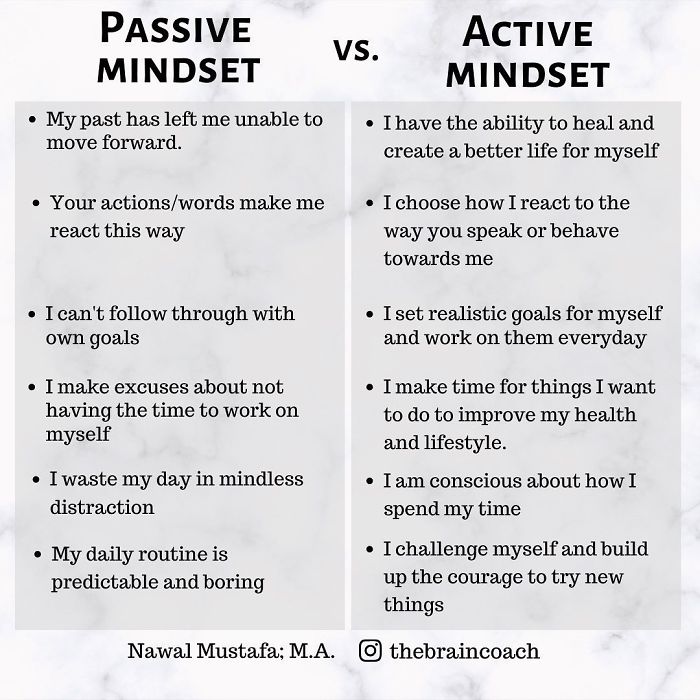
Image credits: thebraincoach
#4
Our thoughts influence how we feel and behave towards a situation. This is the basic concept behind cognitive behavioral therapy. In this post, I share with you examples of cognitive distortions we may have when experiencing low self-worth and how they can be restructured into a rational thought. Do any of these resonate with you?
Cognitive distortions are irrational, inflated thoughts that negatively distort our perception of reality. They play a significant role in perpetuating our psychopathological states (i.e. depression/anxiety). These maladaptive thought patterns are usually automatic and can be difficult to identify if we aren’t aware of them
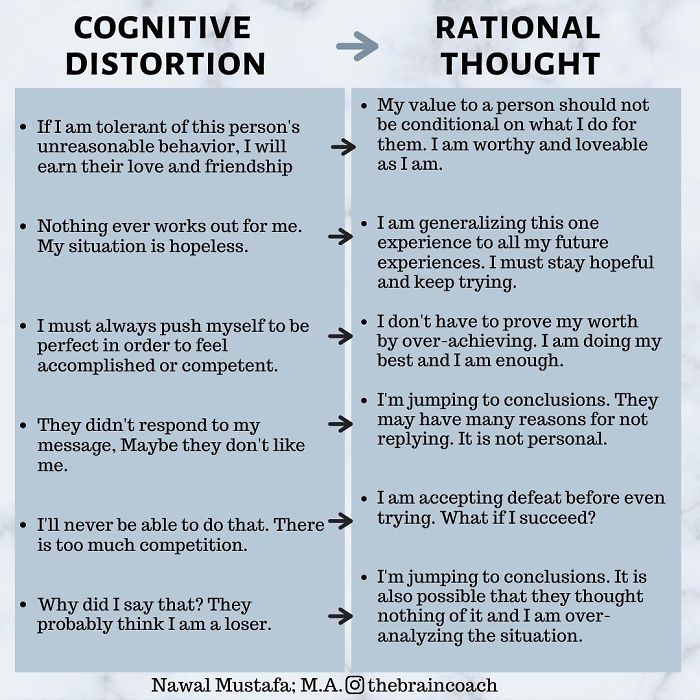
Image credits: thebraincoach
#5
Boundaries are our own personal limits on how people treat us, behave around us, and what they expect from us.
It is difficult to set boundaries around parents because they take care of us, put a roof on our head, support us financially, so we may feel indebted to them. Similarly, our siblings would go great lengths to protect us and keep us happy. In a codependent family dynamic, we are valued based on what we can give. Also, we don’t see other people setting or respecting boundaries, so challenging these expectations of us can be very difficult. Unfortunately, we can be left feeling powerless and anxious when our boundaries are chronically breached.
On the left side of this post are some examples of unhelpful ways we communicate boundaries (personal attacks, passive aggressive comments, rude tone) which will likely lead to more conflict. On the right are some effective and respectful ways you can communicate a boundary. Notice that “I” statements are used rather than “you”. This is important so the other person does not feel threatened.
When setting boundaries, you don’t have to explain yourself as long as you communicate it kindly while being clear and direct. However, you will notice that I provide explanations in some of these examples. I do this because sometimes an explanation allows the other person to understand why you are implementing this boundary and increases the chance of them respecting it. There is no need to over-explain though as long as your tone is gracious. Still, you may experience resistance but that does not necessarily mean you are doing something wrong (even if you internally feel that way). Expect the pushback, but remain firm.
Setting boundaries is an extremely difficult practice. With time, it gets easier and will allow for peace of mind by protecting your energy
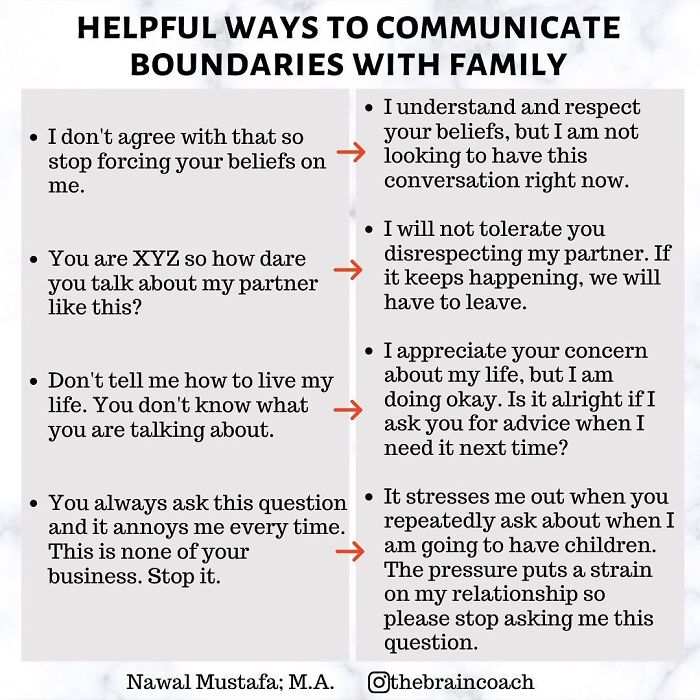
Image credits: thebraincoach
#6
We are able to change the way we feel and behave by identifying our negative thoughts and changing the meaning we give them. This is the basic concept behind cognitive behavioral therapy. In this post, I share with you examples of cognitive distortions we may have when experiencing anxiety and how they can be reframed into a more rational thought. Do any of these resonate with you?
Cognitive distortions are irrational, inflated thoughts that negatively distort our perception of reality. They play a significant role in perpetuating our psychopathological states (i.e. depression/anxiety). These maladaptive thought patterns are usually automatic and can be difficult to identify if we aren’t aware of them
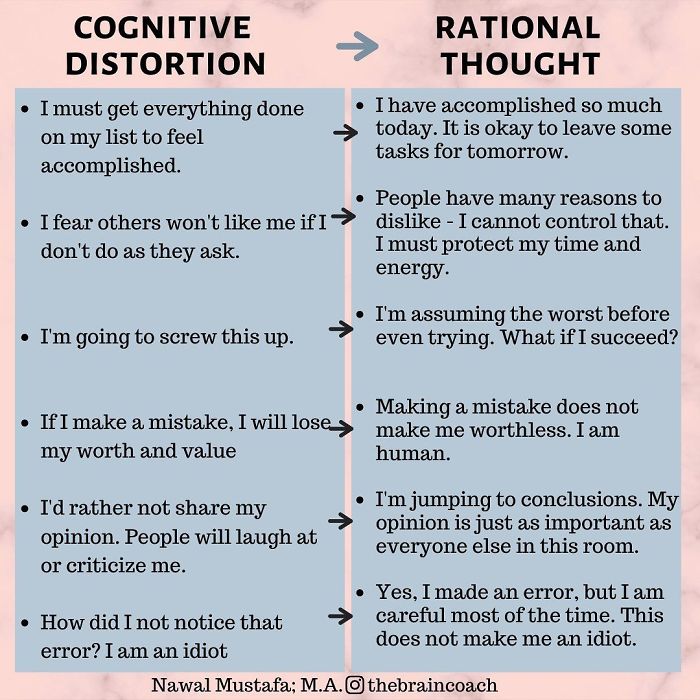
Image credits: thebraincoach
#7
When we are in a codependent relationship, we tend to give endlessly and forget to take care of ourselves. We have a strong need to please, feel accepted, and validated by our significant other. This extreme amount of dependence results in us losing touch with who we are. It takes a toll on our self-esteem and results in feelings of depression and anxiety. ⠀⠀⠀⠀⠀⠀⠀⠀⠀⠀⠀⠀⠀⠀⠀⠀⠀⠀⠀⠀⠀⠀⠀⠀⠀⠀⠀⠀⠀⠀
As children, we don’t have the cognitive ability to distinguish a healthy relationship from an unhealthy one. We idolize our parents and believe they are always right, even when they are unable to provide a supportive and stable home environment (i.e. neglecting, blaming, shaming, judging). So, we subconsciously blame ourselves for our parents’ mistakes and learn that we are inherently bad, unworthy, stupid, or incapable. As we grow up, we carry these parts of ourselves with us. ⠀⠀⠀⠀⠀⠀⠀⠀⠀⠀⠀⠀⠀⠀⠀⠀⠀⠀⠀⠀⠀⠀⠀⠀⠀⠀⠀⠀⠀⠀
This is painful and confusing. However, we can unlearn these behaviors we adopted to seek love and survive as children. They don’t serve us anymore. Our parents were not able to meet our needs, but that does not mean we are flawed. The good news is that by consciously working on ourselves we can break these patterns
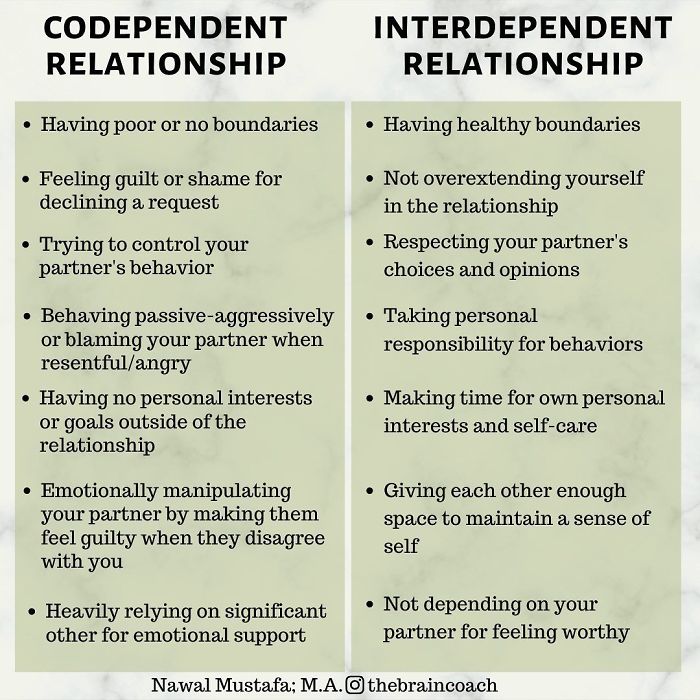
Image credits: thebraincoach
#8
Our thoughts influence how we feel and behave towards a situation. This is the basic concept behind cognitive behavioral therapy. For example, what is the difference between a person who remains hopeful despite failing and a person who immediately gives up after failing? The answer lies in the person’s thinking patterns.
Cognitive distortions are irrational, inflated thoughts that negatively distort our perception of reality. They play a significant role in perpetuating our psychopathological states (i.e. depression/anxiety). These maladaptive thought patterns are usually automatic and can be difficult to identify if we aren’t aware of them. In this post I share with you examples of cognitive distortions and how they can be restructured into a more rational thought. In my next few posts, I will go into more detail about the types of cognitive distortions and how to work on restructuring them
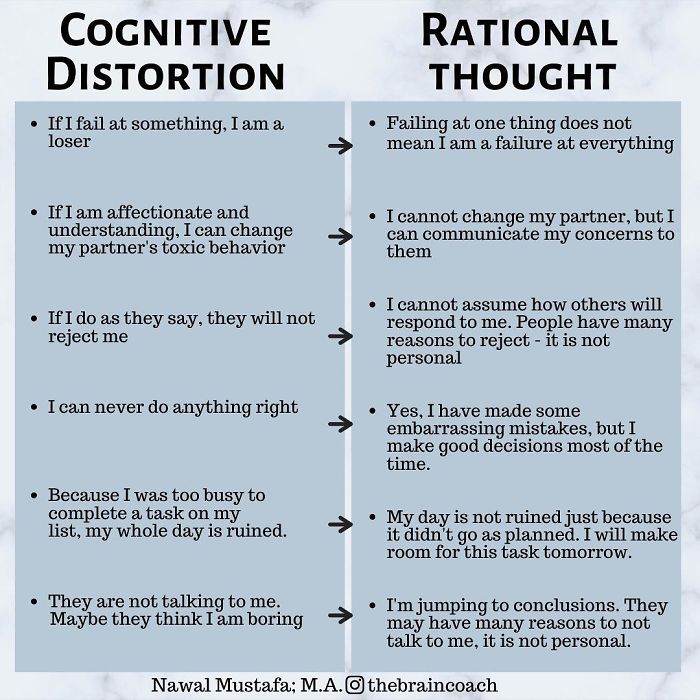
Image credits: thebraincoach
#9
As people-pleasers, we may tend toward being too passive. This is because we struggle with saying “no”. We are agreeable and end up compromising our own needs to make others happy. This prevents us from being truly understood because we are suffocating so much of who we are. Keeping those feelings inside or tiptoeing around conflict can be stressful.
Assertive communication is a healthy way to communicate. It is direct, calm, and respectful. It allows us to feel understood without hurting or violating the rights of others. By communicating assertively, we get our needs met, we show respect for ourselves, and ultimately have better relationships with others.
Note: assertive communication is different from aggressive communication. Aggressive communication consists of yelling, rude gestures, threats, or intimidation. It is important to understand that we do not have to be loud and dominant in order to be heard
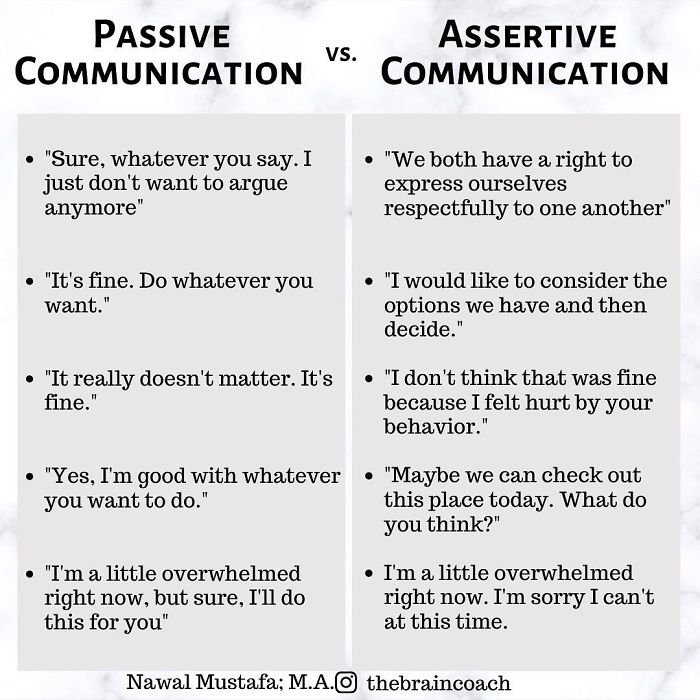
Image credits: thebraincoach
#10
Setting healthy boundaries is something I’ve only recently started to implement in my life. It isn’t easy for me and I’m learning as I go but I want to share the techniques I’ve learnt and been using because this seems to resonate with many of you. Basically, boundaries are our own personal limits on how people can treat us, how they can behave around us, and what they expect from us. This is very difficult, especially if you have lived most of your life in a codependent/enmeshed environment where you don’t see other people setting or respecting boundaries. ⠀⠀⠀⠀⠀⠀ ⠀⠀⠀⠀⠀⠀⠀⠀⠀⠀⠀⠀⠀⠀⠀⠀⠀⠀⠀⠀⠀⠀⠀⠀⠀⠀⠀⠀ ⠀⠀⠀⠀ When learning to set boundaries, the first step is to become self-aware of when you feel overwhelmed or mentally exhausted. Identify when you need more space, time, or self-respect. ⠀⠀⠀⠀⠀⠀ ⠀⠀⠀⠀⠀⠀⠀⠀⠀⠀⠀⠀⠀⠀⠀⠀⠀⠀⠀⠀⠀⠀⠀⠀⠀⠀⠀⠀ ⠀⠀⠀⠀⠀⠀
Once you have identified this, start setting simple but firm boundaries. It is important you use a kind and respectful tone when you communicate this. This will not be easy at first, but once you start implementing it more, you will notice how worthwhile it can be. ⠀⠀⠀⠀⠀⠀ ⠀⠀⠀⠀⠀⠀⠀⠀⠀⠀⠀⠀⠀⠀⠀⠀⠀⠀⠀⠀⠀⠀⠀⠀⠀⠀⠀⠀ ⠀⠀⠀⠀⠀⠀⠀⠀
The goal is to use simple and direct language. There is no need to over-explain or defend. It is important to be firm, yet kind and pleasant. Your tone is everything here. For example, you may notice these example statements may come off rude if your underlying tone is unkind. But if you say the same statement in a gracious way, your words will be perceived in a respectful manner. If the other person still does not want to accept your boundary, repeat it again. ⠀⠀⠀⠀⠀⠀ ⠀⠀⠀⠀⠀⠀⠀⠀⠀⠀⠀⠀⠀⠀⠀⠀⠀⠀⠀⠀⠀⠀⠀
Stand your ground and stay strong. If you give into the other person’s resistance, you invite him/her/them to ignore your needs. ⠀⠀⠀⠀⠀⠀ ⠀⠀⠀⠀⠀⠀⠀⠀⠀⠀⠀⠀⠀⠀⠀⠀⠀⠀⠀⠀⠀⠀⠀⠀⠀⠀⠀⠀ ⠀⠀⠀⠀⠀⠀⠀
How have you tried to set boundaries in your life? What works for you? What you share is valuable because we all can learn from each others’ experiences
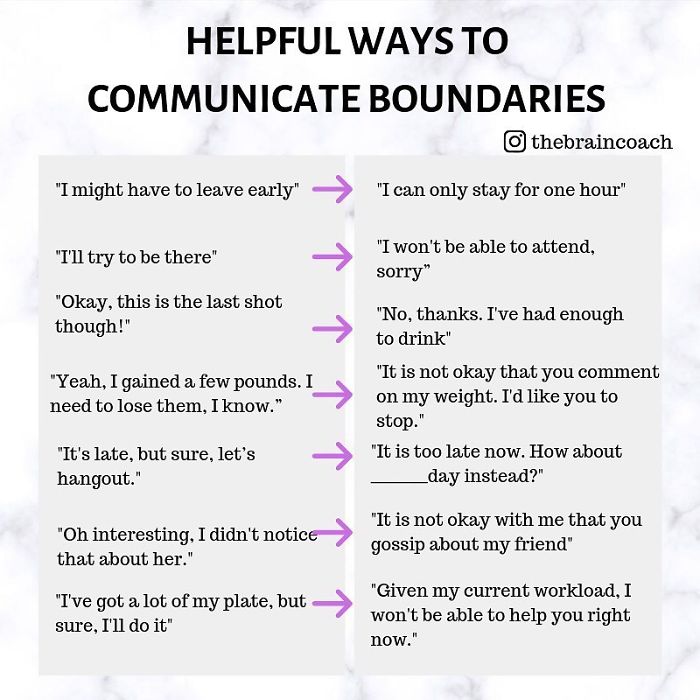
Image credits: thebraincoach
#11
Many of us feel dissatisfied and unhappy because we refuse to accept situations or things that we cannot change or have no control over. The only thing we can control is our response. We only begin to heal once we understand this and start to focus on our inner world.⠀
During times of distress, we become fearful and enter survival mode. We lose our focus and cannot regulate the emotions we experience. This results in us trying to change those around us who we have no control over. This is a recipe for disaster.
When you start to feel overwhelmed with emotions, take a moment to practice mindfulness. Find a quiet place and identify the feelings running through your body and the thoughts running through your mind. Bring them into your consciousness and focus your efforts on changing what you can and accepting what you cannot. ⠀⠀⠀⠀⠀⠀
Take care of your mind and body. Love, Nawal
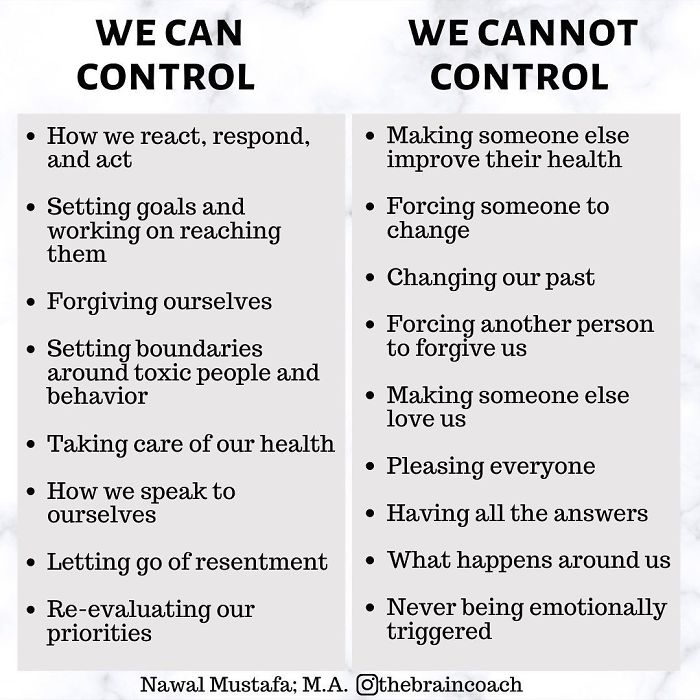
Image credits: thebraincoach
#12
In this post are some examples of how we can assess our needs when we are experiencing a burnout. The “tool-kit” I mention in my last post would look something like this.
Burnout is extreme stress or fatigue that negatively affect our emotional health, personal well-being, and work ethic. It is a state of constantly feeling exhausted feeling emotionally drained and cynical. It leaves us discouraged and we lack enthusiasm about the work we are doing.Workplace burnout is now officially recognized as a mental health concern by the World Health Organization who included it in its International Classification of Diseases (or ICD-10)
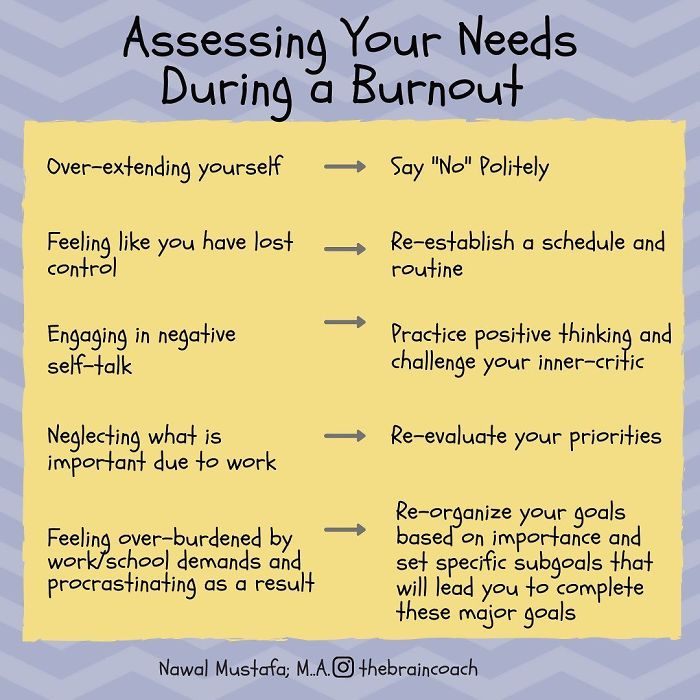
Image credits: thebraincoach
#13
“What-if” thoughts can be beneficial in preparing us for potentially harmful situations. However, if you’ve learned to always approach uncertainty with *fear* rather than *hope*, this can become problematic and hinder you from growth and achieving your goals.
Chronic “what if” thoughts is a learned cognitive style that can be unlearned. Try to notice when you are engaging in these thoughts and redirect them into more positive ones. By doing this exercise, we can alter our emotional and behavioral responses based on how we are thinking in the present. .
If you feel comfortable sharing, I would love for you to redirect a fear-based “what-if” thought you may be experiencing or have experienced in the past (as shown in the post). If not, I encourage you to try this exercise on your own and observe how you feel
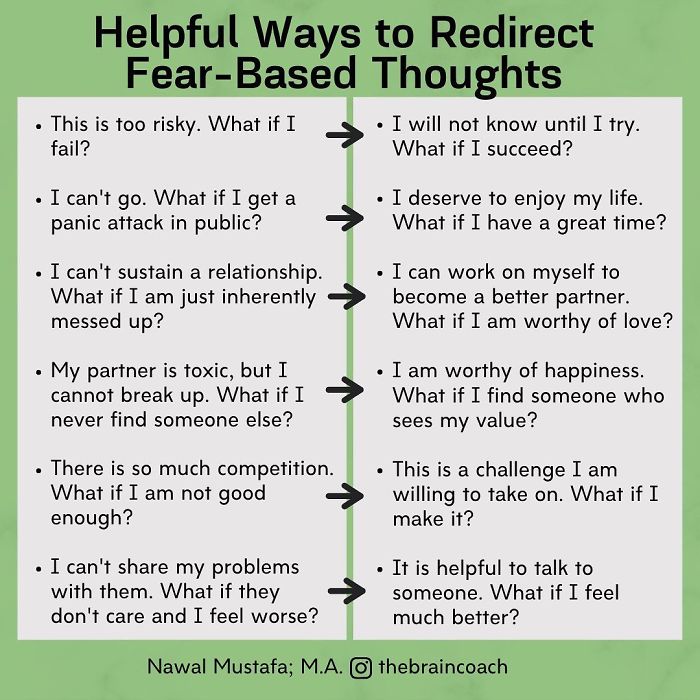
Image credits: thebraincoach
#14
When we get upset or frustrated, it is critical to communicate how we feel. This can be healthy and productive if done the right way, but it can also lead to more frustration and trauma if done in an unhealthy way. Identifying the differences between “healthy venting” and “emotional dumping” can allow us to communicate our anger more effectively and find clarity in our relationships.
These are a set of guidelines Dr. Judith Orloff recommends in her book “The Empath’s Survival Guide”. If you are an empath like me, you will notice yourself feeling drained and having low self-worth after experiencing (receiving or delivering) emotional dumping.
It is also important to create boundaries when someone is emotionally dumping on you. One way to do this is by politely asking to talk about the issue when the other person (or both of you) are calmer.
How do you communicate your frustration? What helps you and what seems to overwhelm you?
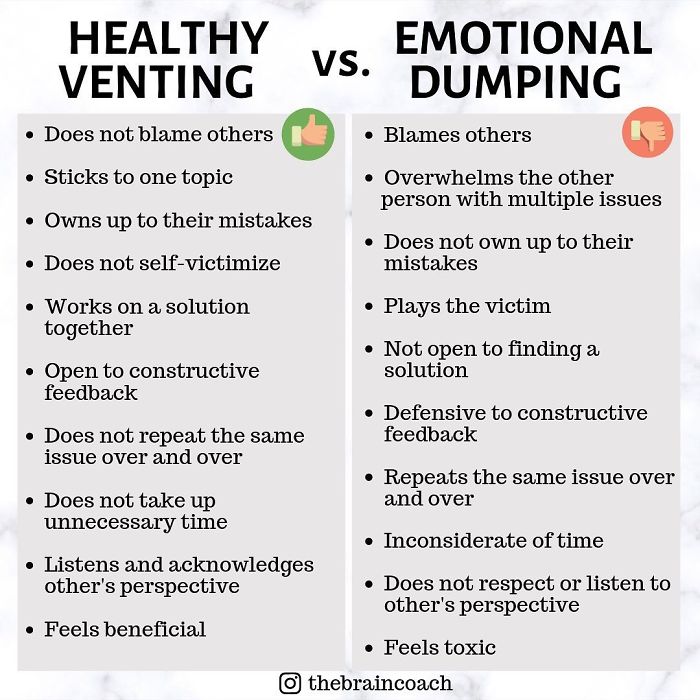
Image credits: thebraincoach
#15
Dr. George Vaillant categorizes defense mechanisms into four levels. Level four consists of mature defenses that he theorizes are fairly common in emotionally healthy adults. He mentions that the use of these defenses enhances pleasure and feelings of control. In addition, they allow us to integrate conflicting emotions and thoughts, while still remaining effective.
Do you use any of these mature defenses?
the word ‘Immature’ here is a categorization used in a defense mechanisms theory by Dr. George Vaillant. It is not me labelling these defense mechanisms as immature.
Dr. George Vaillant categorizes defense mechanisms into four levels. Level two consists of immature defenses that are present in adults but more commonly found in adolescents. We adopt these defenses to protect ourselves from distress and anxiety produced by threatening people or uncomfortable reality. Excessive use of these defenses may result in immature, socially undesirable, and difficult to deal with behavior.
Other defense mechanisms in level two consist of idealization (a form of distortion when you unconsciously choose to perceive another person as having more positive qualities than they actually do) and projection at a less extreme level than what is seen in the level 1 category (see previous post on Pathological Defences). In my next few posts I will be sharing with you the remaining two levels of defences introduced by Dr. Valiant: level three (neurotic defences) and level four (mature defences)
Somatization is an interesting defense mechanism that occurs when our psychological concerns are converted into physical symptoms. They don’t have an underlying physical cause, but are very real. I usually experience intense headaches during times of extreme stress. Other examples of somatization are throwing up from anxiety or feeling physically weak after trauma. These symptoms are usually temporary but can become a clinical concern when they are chronic and cause severe distress.
Defense mechanisms are psychological strategies that our unconscious mind adopts to manipulate, deny, or distort reality. We do this to defend ourselves against feelings of anxiety, anger, fear, and guilt. Defense mechanisms can be healthy too, depending on the circumstance or frequency in which the mechanism is used. They only become unhealthy when we their persistent use results in maladaptive behaviors that negatively affect our relationships and sense of self.
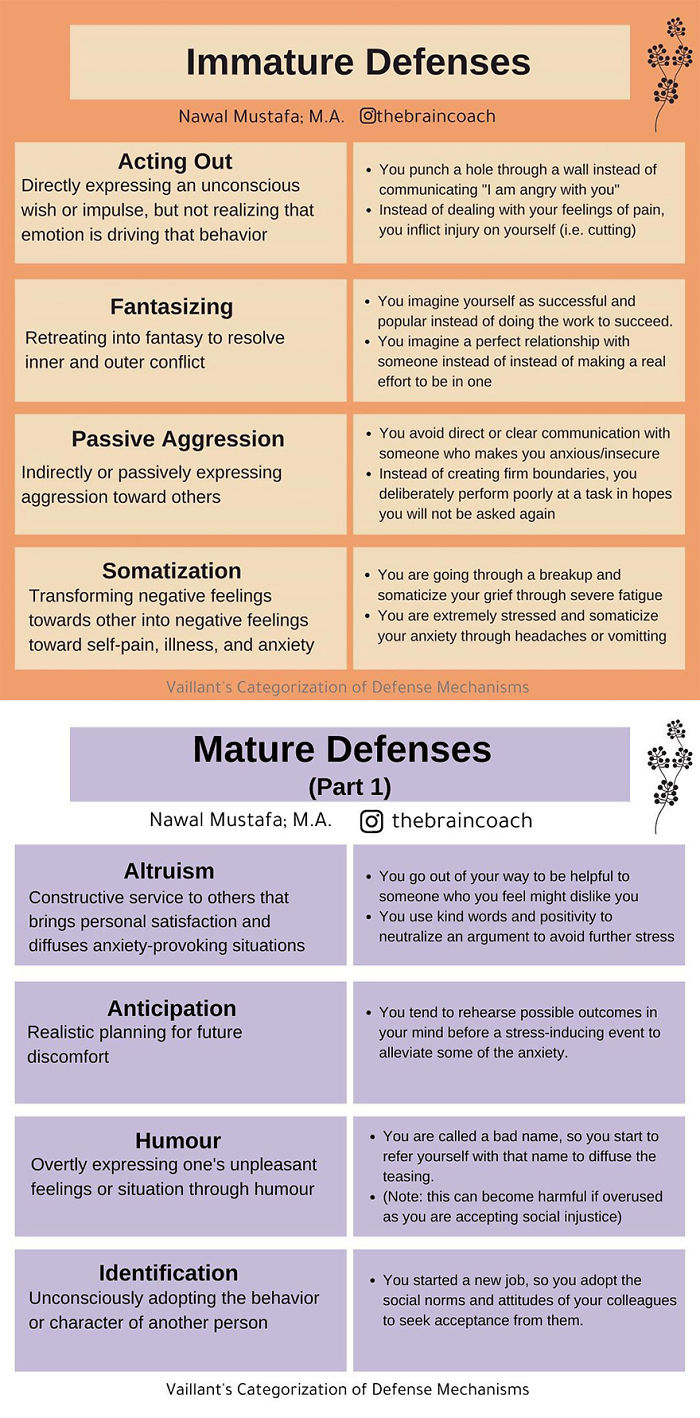
Image credits: thebraincoach
#16
This post shows another example of how thinking errors ultimately change the way we feel and act upon a situation. We may be susceptible to getting caught in the negative thinking pattern (left) if we are already experiencing anxiety or low self-esteem. This is why it is important to recognize when our thoughts are distorted and question them until this way of self-regulating becomes automatic for us. .
Note: these thoughts, feelings, and behaviours are examples used for psychoeducational purposes only. The *situation* here can lead to various types of negative thinking patterns. Humans are complex and no one person reacts exactly the same in a certain situation
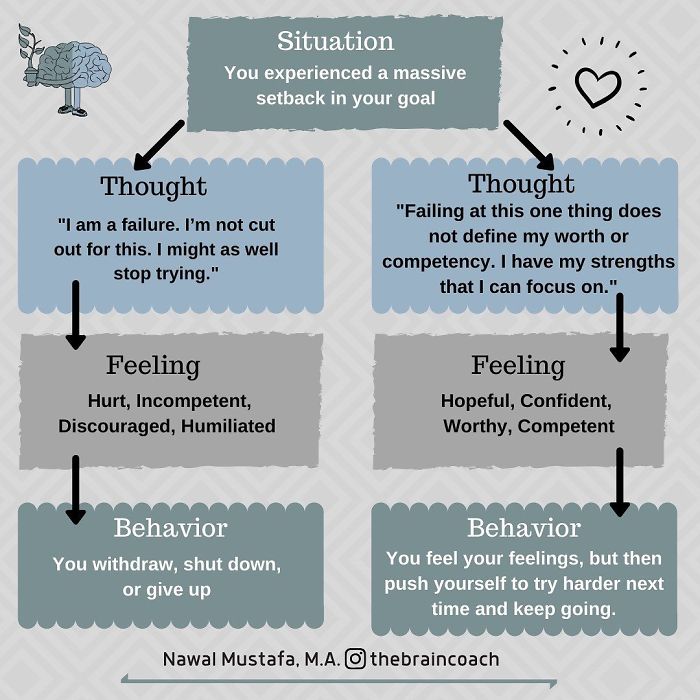
Image credits: thebraincoach
#17
This post shows an example of how thinking errors ultimately change the way we feel and act upon a situation. We may be susceptible to getting caught in the negative thinking pattern (left) if we are experiencing anxiety or low self-esteem. This is why it is important to recognize when our thoughts are distorted and question them until this way of self-regulating becomes automatic for us
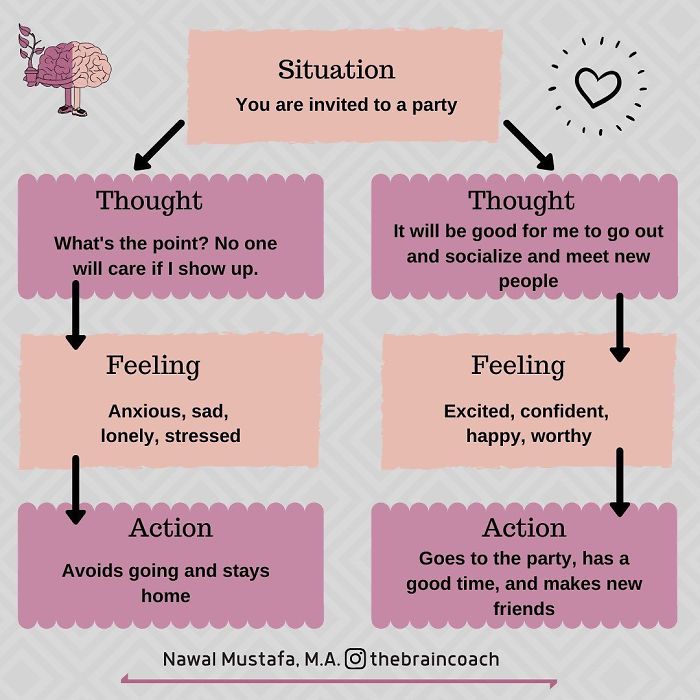
Image credits: thebraincoach

No comments